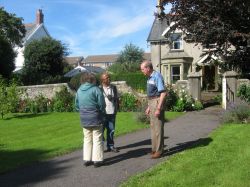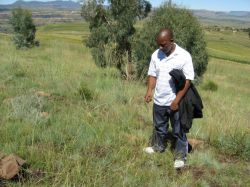a. Field Research Sites
For each site, oral histories of its establishment and existence are being collected guided by open-ended survey forms.
Purpose

Mr. Peter Henry, former Director, Lesotho Woodlot Project at his home in Porthcawl, Wales
Local residents have memories of historical landscape dynamics and landuse systems and their changes. They also have perceptions and interpretations of these and other events that can only be accessed by asking questions. The information gathered will complement that of the written record, providing for a deeper analysis than could be had when using only external sources of information. The interviews also serve as historical ground-truthing of the aerial photography, providing the opportunity for more precise and refined interpretation of the photographs.
Technique
Dr. Tsikoane (degrees in history and development studies) and Dr. Showers (degrees in anthropology, soil science and agronomy) worked together to prepare drafts of questionnaires to which Dr. Letsela (conservation biology) added ideas. Open-ended questionnaires were written for five categories of informants: Chiefs and foremen (of the tree planting work crews - all were men); tree planters; individuals who had private tree plots; randomly selected individuals, and focus groups.

Forest Failure: Dr. Tsikoane indicates hole where planted tree had died. Ha Ralejoe, Lesotho
Implementation
Dr. Tsikoane and Dr. Letsela interviewed the Chiefs and headmen. Interviews with villagers are, and will continue to be, collected by the Field Assistants. After the April 2007 frost, 4 additional field assistants were hired to help with the collection of oral histories. These were also recent graduates, but trained in the social sciences. A full day of orientation included a morning of project presentation and discussion, and an afternoon in the field at a research site. Dr. Showers presented an overview of the project and Dr. Tsikoane led discussions about techniques for interviewing and village deportment. Accompanied by a representative of the Chief, the team spent the afternoon at the newest research site. Dr. Letsela explained the methods of a botanical survey. The 8 Research Assistants were then paired to form interview teams constituted of one male, one female, one social scientist and one biological scientist, and those experienced with the botanical survey. The pairs then walked a transect, with the experienced field assistants teaching the new additions about transect work.
With this orientation the entire team had an understanding of the biophysical reality of the forest for which interviews would be collected. As they moved back to the sites where only botanical surveys had been made, the entire team would walk the forest before asking questions of the villagers. The Senior Researchers firmly believe that it is impossible to carry out useful environmental history interviews without an understanding of the informant's biophysical reality. The importance of interdisciplinary teams when collecting oral histories of landscapes has been demonstrated in Lesotho (see Showers and Malahleha 1992; Showers 2005), and the significance of gender in interview situations is well-known.
All interviews are being recorded, translated and transcribed.
b. Institutional Histories
Purpose:
To understand why tree planting in general, and the woodlot project in particular, was thought to be important, and how it came into existence.
Technique
Past and current tree planting administrators are being interviewed to understand the project's broader context. People resident in UK, Europe and Lesotho will be/have been contacted.
Implementation
Dr. Showers will use her trips and residence in UK to contact northern hemisphere informants. The entire team of Senior Researchers will be involved with interviewing people resident in Lesotho.
Where possible, interviews will be taped and transcribed (translated if not in English).


